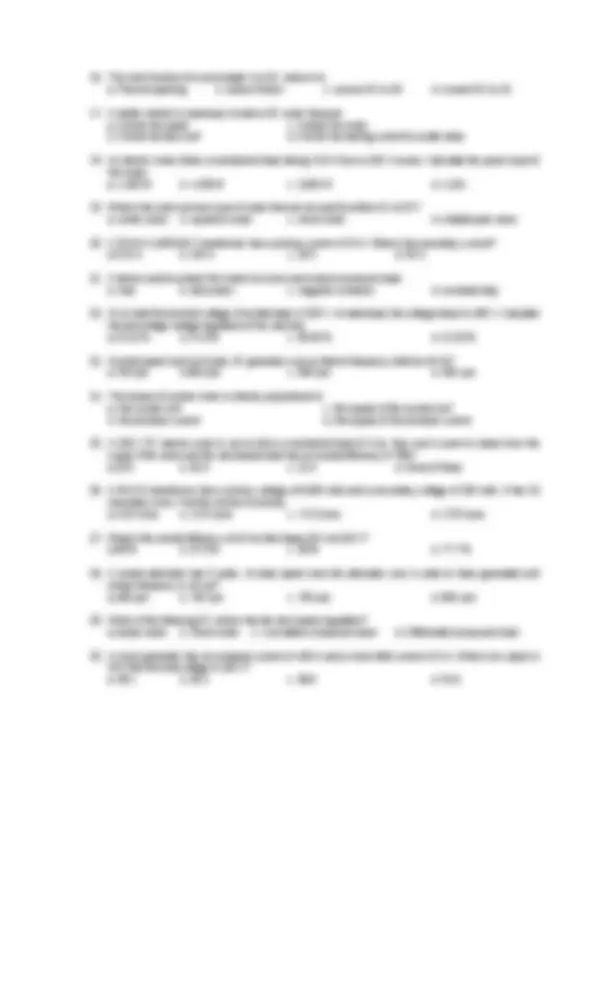TECHNOLOGICAL INSTITUTE OF THE PHILIPPINES
938 AURORA BOULEVARD CUBAO QUEZON CITY
ELECTRICAL ENGINEERING DEPARTMENT
DC MACHINES
Name:____________________________________________Score____________________
Direction. Write the letter of the correct answer. Give your step by step solution on the
provided solution pad. No solution is considered wrong.
1. The hysteresis loss in a 6,600 Volts, 60 Hz transformer is 480 watts. What will be the loss when the
transformer is connected to a 6, 900 V, 40 Hz source?
a. 558 W b. 657 W c. 520 W d. 417 W
2. Calculate the percent voltage regulation for a transformer with a percent resistance of 2% and a reactance
of 4% of rating 550 KVA, when delivering 450 kVA at 0.6 pf lagging.
a. 5.5% b. 4.2% c. 4.4% d. 3.6%
3. The eddy current loss in a 2300 V, 60 Hz transformer is 280 watts. What is the eddy current loss at 2400 V,
50 Hz supply of electricity?
a. 280 W b. 300 W c. 305 W d. 257 W
4. A single phase, 100 kVA, 2400/240 Volt, 60 Hz transformer has a primary resistance of 0.828 Ω and a
secondary resistance of 0.009 Ω. Calculate the equivalent resistance referred to the primary.
a. 1.728 Ω b. 0.837 Ω c. 1.6 Ω d. 1.46 Ω
5. Which DC Motor cannot be used without a load connected to it?
a. Shunt b. Series c. Compound d. Universal
6. A shunt motor armature has a resistance of 0.07 ohms and a current of 50 Amps at 120 Volts. What is the
back emf or counter emf of the motor?
a. 108.5 V b. 116.5 V c. 112.2 V d. 118.3 V
7. A 440 V shunt motor has Ra = 0.8 Ω and RSH = 200 Ω. What is the back emf when giving an output of 7.46
KW at 85 % efficiency?
a. 465.8 V b. 425.8 V c. 400 V d. 440 V
8. A DC Shunt Motor develops 15 hp at 120 V. The armature efficiency is 95 %. What is the armature
resistance?
a. 0.10 Ω b. 0.06 Ω c. 0.08 Ω d. 0.60 Ω
9. A DC Shunt Motor develops 15 hp at 120 V. If Ra = 0.061 Ω and ISH = 2 A. What is the overall efficiency?
a. 90 % b. 93 % c. 95 % d. 94%
10. A 5 KW, 220 V DC Shunt Motor has a line current of 30 Amps. Ra = 0.3 Ω and RSH = 200 Ω. What is the
constant loss of this motor? (Core Loss)
a. 1600 W b. 1350 W c. 250 W d. 1500 W
11. The no load speed of the compound motor is 1650 rpm. How fast will it operate when it delivers rated
horsepower output, if the speed regulation is 12.5 %?
a. 1444 rpm b. 1856 rpm c. 1467 rpm d. 1500 rpm
12. The current flowing in the armature conductors of a DC motor is
a. DC b. AC c. AC and DC d. transients
13. If the current in the armature of a DC series motor is reduced to 50 %, the torque of the motor will be
a. 50 % of the previous value b. 25 % of the previous value
c. 150 % of the previous value d. 125 % of the previous value
14. Which of the following is a correct statement about series motor?
a. Field winding consist of few thicker wire b. run easily without a load
c. Almost constant speed d. poor torque
15. If the back emf in a DC motor is absent, then
a. Motor will run at very high speed b. motor will not run
c. Motor will run at low speed d. motor will burn










